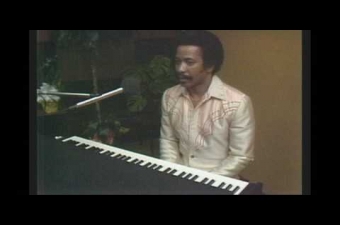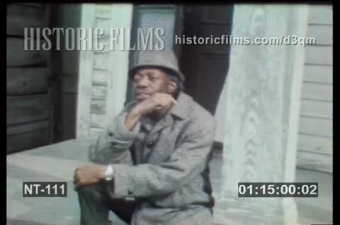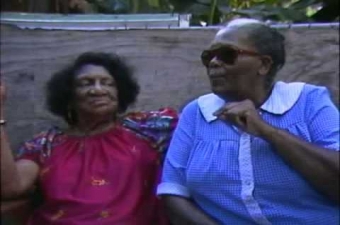Caldonia Inn
942 Henriette DeLilleNew Orleans LA 70116
To visit this site, enter Louis Armstrong Park at 801 N Rampart Street, turn right, and proceed to the far side of the lagoon. The building was at the intersection of St. Claude and St. Philip Street, half of which remains just outside the park’s perimeter fence.
“Uncle” Lionel Batiste, the drummer, singer, grand marshal, and bon vivant, said he was born on the second floor of this building in 1932 (his obituary said he was born in 1931; one imagines Batiste grinning at the discrepancy). His family worked for the building’s owner, Michael Tessitore, who ran a grocery store and saloon downstairs. After stints as the Japanese Tea Room and the Gypsy Tea Room II, it opened as the Caldonia Nite Club in 1947, and was called the Caldonia Inn by the early 50s.
In March 1948 Tessitore hired a piano player named Henry Roeland Byrd (1918 -1980), and gave him the nickname Professor Longhair—the title of “Professor” had been bestowed on New Orleans piano players since the days of Storyville, and “Longhair” referred to Byrd’s relaxed coiffure. His backing band, the Three Hair or Four Hair Combo depending on the night, included guitarist Walter “Papoose” Nelson, who went on to play in Fats Domino’s band.
Professor Longhair’s distinctive style, particularly the Latin-influenced rhythms he played with his left hand, has influenced every New Orleans piano player since. Allen Toussaint called him, memorably, “the Bach of Rock.” When Eddie Bo was a kid he stood outside the Caldonia to listen to Byrd on Sunday evenings. In 1949 a record label based in Dallas found Byrd and cut the original version of “Mardi Gras in New Orleans,” which included a lyric about seeing the Zulu King on St. Claude and Dumaine, just up the block from the Caldonia. (King Zulu that year was Louis Armstrong, and the Caldonia had been a stop on his parade route.)
Though they are considered classics today, Byrd’s records sold modestly, and by the mid-1960s he was sweeping up at the One Stop Record Shop on South Rampart Street, the strip where he’d tap-danced for change as a kid. In 1970, though, some young, white promoters put helped Byrd jumpstart a late-career revival. He became a fixture at the new Jazz & Heritage Festival, and inspired the opening of the Uptown nightclub Tipitina’s in 1977. He was a local hero at the time his death in 1980.
While the Caldonia is best remembered for launching Professor Longhair, in its day it was known for drag shows (the club’s name evoked Louis Jordan’s 1945 jump blues hit “Caldonia,” which was reputedly about a drag queen.) The Caldonia was also welcoming to gay patrons—Byrd recalled playing a gay wedding there. As Trumpeter Frank Mitchell told author Jeff Hannusch, “The Caldonia had the best female impersonator show in the city. It was so popular that the white sissies started coming there until the police ran them off. We’d back their show and then play two sets of dance music.” (The use of the term ”sissy” in this context prefigures the “sissy bounce” label that Big Freedia and other gay and trans artists embraced in the 2000s.)
St. Philip Street was a well-trod second line route, and the Caldonia was a popular parade stop through the 50s and 60s. Standout drummers James Black and John Boudreaux grew up around the corner and across the street from the club, respectively, taking in the rhythms of Yellow Pocahontas Mardi Gras Indians and brass bands playing for social aid and pleasure clubs like the Treme Sports.
The Caldonia met an untimely end in 1971 when the city leveled it and several surrounding blocks to make way for a “cultural center” that never came to be. The irony of bulldozing the Caldonia in the name of culture was not lost on neighborhood residents, who protested with a mock jazz funeral. While the Olympia Brass Band played a dirge, pallbearers threw a coffin containing a dummy into the building before it was demolished. There was also a procession to a new Caldonia club at 1533 St. Philip Street with a velvet-lined casket. Inside it, Uncle Lionel played the corpse.
For more about Louis Armstrong Park, click here.
For more about the Treme neighborhood, click here.
Videos

Professor Longhair and Allen Toussaint discuss Longhair's distinctive style; a brief performance clip follows.
Video by stevensonpalfi.
Professor Longhair and Allen Toussaint discuss Longhair's distinctive style; a brief performance clip follows.

Rare archival interview with Professor Longhair from 1969, the eve of his late-career revival.
Video by Historic Films Stock Footage Archive.
Rare archival interview with Professor Longhair from 1969, the eve of his late-career revival.

From 1982, Treme residents Iona Rayon and Beatrice Austin recall the symbolic jazz funeral for the Caldonia eleven years earlier.
Video by Alan Lomax Archive.
From 1982, Treme residents Iona Rayon and Beatrice Austin recall the symbolic jazz funeral for the Caldonia eleven years earlier.
Images















